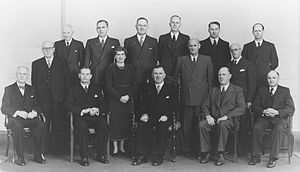This article needs additional citations for verification. (May 2010) |
First National Government | |
|---|---|
Ministries of New Zealand | |
| 1949–1957 | |
 | |
| Date formed | 13 December 1949 |
| Date dissolved | 12 December 1957 |
| People and organisations | |
| Monarch | George VI Elizabeth II |
| Prime Minister | Sidney Holland (1949–57) Keith Holyoake (1957) |
| Deputy Prime Minister | Keith Holyoake (1954–57) Jack Marshall (1957) |
| Member party | National Party |
| Opposition party | Labour Party |
| Opposition leader |
|
| History | |
| Elections | 1949 general election 1951 general election 1954 general election |
| Predecessor | First Labour Government of New Zealand |
| Successor | Second Labour Government of New Zealand |
The First National Government of New Zealand was the government of New Zealand from 1949 to 1957 formed by the National Party. It was a conservative government best remembered for its role in the 1951 waterfront dispute. It also began the repositioning of New Zealand in the Cold War environment. Although New Zealand continued to assist Britain in situations such as the Malayan Emergency, it now became connected to Australia and the United States through the ANZUS agreement.
Domestically, the First National Government presided over a steady rise in the average standard of living, and by 1957 New Zealand was, in the words of the historian Keith Sinclair, "a materialist's paradise." In 1957, the National Party published a book entitled A Record of Achievement: The Work of the National Government, 1949–1957, detailing its accomplishments in office. Under National's leadership, according to the publication, people now had more money, pensions, cattle, sheep, university scholarships, overseas trips, radios, washing machines, vacuum cleaners, electric toasters, houses, motor vehicles, and telephones. As summed up by Sidney Holland in a foreword, 'New Zealand is a happier, healthier and more prosperous nation'.[1]
- ^ A History of New Zealand by Keith Sinclair
